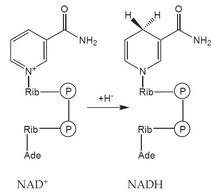Intermediate products of energy metabolism
From WikiLectures
In cells, there are metabolic pathways – a kind of crossroads of mutual transformation of nutrients. These include the ``pyruvate dehydrogenase reaction' (PDH), the ``Krebs cycle (KC) and the respiratory chain (DŘ). Three intermediates, acetyl-CoA, pyruvate' and NADH, have an important position in energy metabolism.
Acetyl-CoA[edit | edit source]
Creation[edit | edit source]
- Pyruvate dehydrogenase reaction (PDH)
- The irreversibility of this reaction is the reason that glucose cannot be formed from the vast majority of fatty acids.
- Degradation of amino acids
- Lysine and leucine are degraded directly to acetyl-CoA, other amino acids are converted via pyruvate.
- β-oxidation of fatty acids and degradation of ketone bodies.
Usage[edit | edit source]
- The Krebs cycle, which is followed by the respiratory chain (and ATP production).
- Synthesis of fatty acids and ketone bodies (with an excess of acetyl-CoA).
- Cholesterol synthesis.
Pyruvate[edit | edit source]
Creation[edit | edit source]
- Aerobic glycolysis.
- Lactate oxidation (catalyzed by lactate dehydrogenase).
- Degradation of some AKs.
Usage[edit | edit source]
- Synthesis of acetyl-CoA (PDH).
- Lactate synthesis – takes place during anaerobic glycolysis, the purpose of which is to regenerate reduced coenzymes NADH + H+ back to NAD+.
- Alanine synthesis (catalyzed by alanine aminotransferase).
- Synthesis of oxaloacetate (catalyzed by pyruvate carboxylase).
- Gluconeogenesis.
NADH[edit | edit source]
Creation[edit | edit source]
- Aerobic glycolysis
- Pyruvate dehydrogenase reaction.
- Beta-oxidation of fatty acids.
- Krebs cycle.
- Oxidation of ethanol.
Usage[edit | edit source]
- The respiratory chain and the formation of ATP.
- Conversion of pyruvate to lactate.


